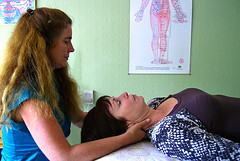How many of you use a laptop as your primary computer? How many of your clients do?
I confess. I’m a laptop user. I got rid of my desktop computer about two years ago when laptop prices and features got to the point where it seemed to make sense to get rid of the bulky old thing in favor of something I could use anywhere. I LOVE the convenience and flexibility. But…
Are Laptops a Pain in the…?
Ever since laptops came out, ergonomics experts have been (justifiably) harping on the inherent problems with extended laptop use. Because the monitor and keyboard are connected, you can’t adjust them separately. It’s interesting—even though laptops are supposed to be the “latest and greatest,” their design actually goes back to the very early days of personal computing when screens and keyboards were integrated in a single unit. It was quickly discovered that this design caused a lot of musculoskeletal issues. Ergonomic design guidelines were written in the 1970’s that called for separation of the screen and keyboard, and that’s how pc’s (and Macs) have been designed ever since. Until we “progressed” to laptops.
So what’s the problem with laptops? In a nutshell, If the keyboard’s at the right height, you’re looking down at the monitor and putting strain on your neck muscles; if you raise the monitor to eye level, the keyboard’s too high and you end up hunching your shoulders and elevating your arms and wrists to type.
Comfortable Laptop Computing
The best way to work ergonomically at a laptop is to connect either a separate keyboard or monitor to your laptop. That way you can position the separate pieces at the right height.
When you’re using your laptop away from your primary location, think about whether you’re going to be doing more typing or more reading. If you’re going to be doing a lot of typing, position the keyboard at the correct height for typing, so your wrists are in a neutral position, your elbows at a 90 degree angle, and your shoulders relaxed. If the table or desk you’re using doesn’t allow proper positioning, try putting the laptop on your lap.
If you’re going to be doing a lot of reading and not so much typing (checking email, watching a dvd, etc.) position the monitor at eye level (if you’re at a standard-height table, this could involve putting something like a phone book or two under the laptop).
And when you’re using the laptop in a way that compromises either keyboard or screen position, it’s even more important to take regular stretch breaks, at least every 30 minutes or so!
To get more in-depth info on laptop ergonomics, check out this Macworld Magazine article and Cornell University’s Laptop Ergonomics Guidelines.


![Reblog this post [with Zemanta]](http://img.zemanta.com/reblog_e.png?x-id=62aa60d3-5f9a-4f8c-a8e6-82b5a6d3757a)




![Reblog this post [with Zemanta]](http://img.zemanta.com/reblog_e.png?x-id=6f389218-df4f-4b0f-8a65-bc3c3f8620f8)
 Full sheet of virtual bubble wrap
Full sheet of virtual bubble wrap